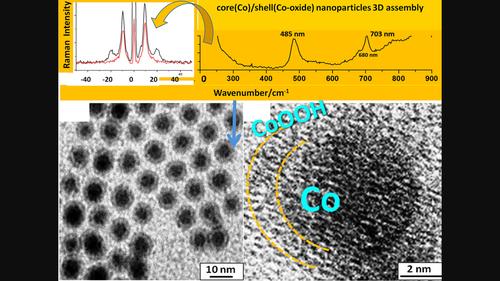当前位置:
X-MOL 学术
›
J. Raman Spectrosc.
›
论文详情
Our official English website, www.x-mol.net, welcomes your feedback! (Note: you will need to create a separate account there.)
Multiscale identification of the inorganic shell of core (Co)/shell‐assembled nanoparticles
Journal of Raman Spectroscopy ( IF 2.5 ) Pub Date : 2024-03-07 , DOI: 10.1002/jrs.6668 Ghilhem Simon 1 , Salvatore Costanzo 1 , Isabelle Lisiecki 1 , Philippe Colomban 1
Journal of Raman Spectroscopy ( IF 2.5 ) Pub Date : 2024-03-07 , DOI: 10.1002/jrs.6668 Ghilhem Simon 1 , Salvatore Costanzo 1 , Isabelle Lisiecki 1 , Philippe Colomban 1
Affiliation

|
Core (Co)/shell (Co‐oxide) nanoparticles assembly exhibits interesting magnetic properties that depend on the inorganic shell characteristic (composition and crystalline structure). Assemblies of pure and partially oxidized cobalt (core/shell) nanoparticles, ~9 nm in diameter, were prepared and analyzed by techniques probing the matter at macroscale to nanoscale: UV–visible‐near‐infrared (NIR) transmission, FTIR, Raman microspectroscopy, and transmission electron microscopy. Attention is paid to compare nonoxidized and (partially) oxidized Co nanoparticles, coated with lauric acid as stabilizing agent (ligands). The approximately 1 nm disordered inorganic coating is perfectly detected by transmission electron microscopy, UV–visible–NIR, infrared, and Raman spectroscopy. The Raman spectrum is sensitive to laser wavelength and power due to the local heating induced by the laser, which modifies the interaction between the organic chains and the nanoparticle inorganic shell. For comparison, nanoparticle films were analyzed under heating from room temperature to 300°C. The “fusion” (dynamic disorder) of lauric (dodecanoic) chains is observed concomitantly with the merging of very low wavenumber Lambs' modes into a Rayleigh wing, which is consistent with an increase in the topological nanoparticle disorder. Hydroxylation or water adsorption is observed for Co film. The UV–visible–NIR and Raman spectra of the Co‐oxide shell do not correspond to that of CoO (rock salt) nor to that of Co3 O4 (spinel) but has some similarity to that of 2D delafossite (CoOOH) phase.
中文翻译:

核(Co)/壳组装纳米颗粒无机壳的多尺度鉴定
核(Co)/壳(Co氧化物)纳米粒子组装体表现出有趣的磁性,这取决于无机壳的特性(组成和晶体结构)。通过从宏观到纳米尺度探测物质的技术制备和分析了直径约 9 nm 的纯和部分氧化的钴(核/壳)纳米颗粒组件:紫外-可见-近红外 (NIR) 传输、FTIR、拉曼显微光谱和透射电子显微镜。注意比较未氧化和(部分)氧化的 Co 纳米粒子,涂有月桂酸作为稳定剂(配体)。透射电子显微镜、紫外-可见-近红外、红外和拉曼光谱可以完美检测到约 1 nm 无序无机涂层。由于激光引起的局部加热,拉曼光谱对激光波长和功率敏感,这改变了有机链和纳米颗粒无机壳之间的相互作用。为了进行比较,在从室温加热到 300°C 的情况下对纳米颗粒薄膜进行了分析。月桂酸(十二酸)链的“融合”(动态无序)伴随着非常低波数的兰姆模式合并到瑞利翼中而被观察到,这与拓扑纳米颗粒无序的增加是一致的。Co 膜观察到羟基化或水吸附。Co氧化物壳层的紫外-可见-近红外光谱和拉曼光谱与CoO(岩盐)和Co的光谱都不对应3 氧4 (尖晶石)但与二维铜铁矿(CoOOH)相有一些相似之处。
更新日期:2024-03-07
中文翻译:

核(Co)/壳组装纳米颗粒无机壳的多尺度鉴定
核(Co)/壳(Co氧化物)纳米粒子组装体表现出有趣的磁性,这取决于无机壳的特性(组成和晶体结构)。通过从宏观到纳米尺度探测物质的技术制备和分析了直径约 9 nm 的纯和部分氧化的钴(核/壳)纳米颗粒组件:紫外-可见-近红外 (NIR) 传输、FTIR、拉曼显微光谱和透射电子显微镜。注意比较未氧化和(部分)氧化的 Co 纳米粒子,涂有月桂酸作为稳定剂(配体)。透射电子显微镜、紫外-可见-近红外、红外和拉曼光谱可以完美检测到约 1 nm 无序无机涂层。由于激光引起的局部加热,拉曼光谱对激光波长和功率敏感,这改变了有机链和纳米颗粒无机壳之间的相互作用。为了进行比较,在从室温加热到 300°C 的情况下对纳米颗粒薄膜进行了分析。月桂酸(十二酸)链的“融合”(动态无序)伴随着非常低波数的兰姆模式合并到瑞利翼中而被观察到,这与拓扑纳米颗粒无序的增加是一致的。Co 膜观察到羟基化或水吸附。Co氧化物壳层的紫外-可见-近红外光谱和拉曼光谱与CoO(岩盐)和Co的光谱都不对应



























 京公网安备 11010802027423号
京公网安备 11010802027423号